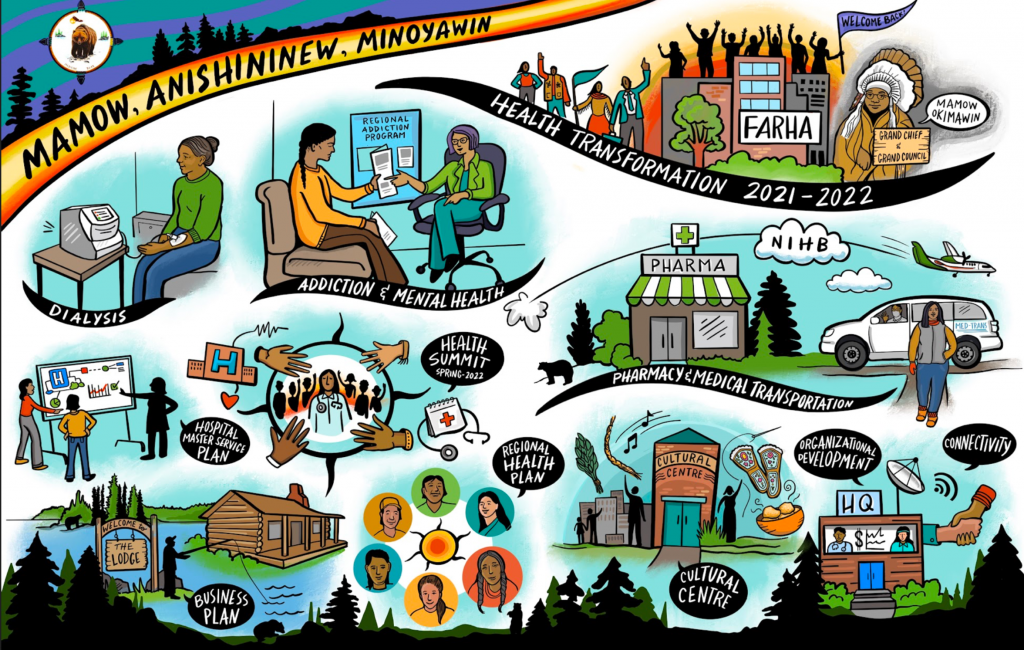Planning & Development Department
"We have to make sure that for the 15,000 people that are in Island Lake, that we are providing support that puts their health status first."

Vacant
Director of Planning & Development
Message from the Director
We Are Building The Future
Planning and Development initiates and implements improvements in regional health services that are in the best interests of the membership. We work closely with the four communities and the Health Directors on projects and programs that will help improve the health status for the 15,000 Island Lake membership.
Our overarching health plan will soon be complete and it goes beyond doing the same things in a modestly different way; the plan calls for different things to be done in a sustainable, regional and quality manner.
This is not transformation; it is transmutation! Four Arrows Regional Health Authority aspires to have responsibility and accountability as a full health authority for insured services with the region and for federal non-insured health services required by the membership.
Mamow, Anishininew, Minoyawin.
Current Projects Being Developed
Governance
The Director of Planning and Development serves as secretariat to the governance working group comprised of community members and leadership. The objective of the governance project is to design a system and a process to strengthen the regional governance for the Island Lake communities. This initiative is core to ensuring that the members of the Island Lake Anishininew Nation receive the services and support required to realize productive, healthy and vibrant communities.
Addictions feasibility study
In March 2018 a several committed community members undertook a ‘meth walk’ to Ottawa to bring awareness and action to the addictions crisis that was gripping the communities of Island Lake. That was the beginning of a process of developing a regional addiction program. At the request of the office of the Minister of Indigenous Services a detailed regional funding request proposal was submitted in October of 2018. In late March 2019 FARHA was approved to proceed with developing a feasibility study for the program including an addictions treatment centre in the communities. A working group of representatives from the communities, subject matter experts and representatives from Manitoba and FNHIB is leading development and finalization of the feasibility study. The study will feature a treatment/recovery centre in one community (that will allow for detoxification programming) and it will also call for aftercare programs in all communities. A major part of the regional program will include training for community health staff and an important emphasis on prevention and health promotion. The feasibility study should be complete in early 2020.
Community assisted home dialysis
For several years the Regional Dialysis program in Garden Hill, Manitoba has been at capacity. With a high prevalence and incidence of disease requiring dialysis, too many members of the Island Lake Anishininew Nation (ILAN) have to relocate to Winnipeg for life-extending treatment. This relocation brings major cultural challenges. Many elders may not have adequate proficiency in English to navigate the Winnipeg health system, nor the activities of daily life. Also, the economic burden is significant. After six months, certain federal non-insured health benefits cease and relocated patients need to make their own way for accommodation and daily living. While local health transportation and health care are provided, major economic pressures arise on family, relatives and other community members. Often, the family home has been given up on reserve. Faced with these circumstance, some members find these ultimate conditions unbearable and return to the community without access to dialysis care.
There is a need to provide more dialysis in the communities. There is a similar strong need to support and expand as much as possible the efforts at eduction, health promotion and prevention to help tide over the current incidence of poor renal health in the region.
Access to the Garden Hill renal program is hindered by scheduled flights that are at best awkward. Members of Red Sucker Lake First Nation (RSLFN) are not able to access the dialysis program in Garden Hill without relocating to that community – which for many reasons is not practical. Essentially, there is no local dialysis service for Red Sucker Lake first Nation. While all of the communities of the ILAN need additional service, the needs for those members from RSLFN are quite notable. RSLFN is thought of as the best place for early action with a pilot program that will be transferable to other ILAN communities.
Over five years ago, the RSLFN leadership and community responded to this need by developing and presenting proposals to the provincial and federal government. Their comprehensive presentation outlined the dramatic unmet need in the community and offered some possible solutions. The recommendations were received with concern but with no direct action given other priorities and strains on the health systems. The advocacy continued for years.
In late 2018 and early 2019 the current leadership and community again presented their proposals to the province and federal government. This led to important meetings in spring/early summer of 2019 with Manitoba Health, Shared Health Manitoba, First Nations and Inuit Health Branch of Indigenous Services Canada and Four Arrows Regional Health Authority. From those meetings Four Arrows Regional Health Authority worked with the Manitoba Renal Program to pull together a group of senior technicians to investigate how to implement Regional Community-Assisted Home Dialysis in Red Sucker Lake First Nation. A full proposal will be submitted in early 2020 with the anticipation of swift approval by Manitoba Health and First Nations and Inuit Health Branch.
Health Transformation Plan

FARHA is developing a comprehensive plan that will outline how to best meet the health needs of its membership. This will tie together the various and numerous projects and programs currently underway at FARHA but also it will outline which programs must be transferred to FARHA in order to ensure effective and efficient activities. This 2020 vision document will layout a transformed future for a responsible and robust regional health authority capable of addressing the health needs of the membership of the Island Lake Anishininew Nation
How to contact me:
Jim Harrold Ph.D.
Interim Director of Planning and Development
Four Arrows Regional Health Authority
jharrold@fourarrowsrha.org